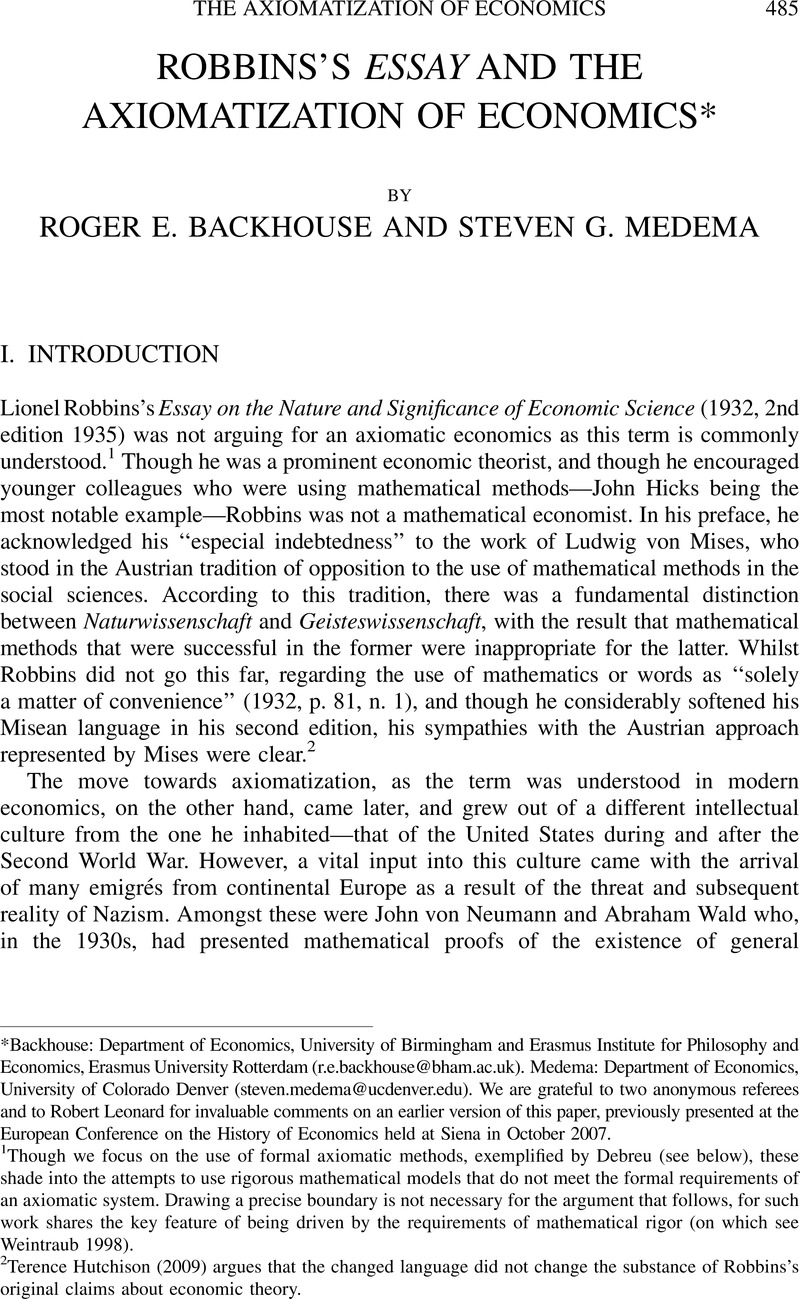Crossref Citations
This article has been cited by the following publications. This list is generated based on data provided by Crossref.
WADE HANDS, D.
2008.
INTROSPECTION, REVEALED PREFERENCE, AND NEOCLASSICAL ECONOMICS: A CRITICAL RESPONSE TO DON ROSS ON THE ROBBINS-SAMUELSON ARGUMENT PATTERN.
Journal of the History of Economic Thought,
Vol. 30,
Issue. 4,
p.
453.
SCARANTINO, ANDREA
2009.
ON THE ROLE OF VALUES IN ECONOMIC SCIENCE: ROBBINS AND HIS CRITICS.
Journal of the History of Economic Thought,
Vol. 31,
Issue. 4,
p.
449.
Isaac, Joel
2010.
Tool Shock: Technique and Epistemology in the Postwar Social Sciences.
History of Political Economy,
Vol. 42,
Issue. Suppl_1,
p.
133.
Backhouse, Roger E.
and
Fontaine, Philippe
2010.
Conclusions: The Identity of Economics—Image and Reality.
History of Political Economy,
Vol. 42,
Issue. Suppl_1,
p.
343.
Backhouse, Roger E.
and
Nishizawa, Tamotsu
2010.
No Wealth but Life.
p.
223.
Lee, Frederic S.
2011.
The Pluralism Debate in Heterodox Economics.
Review of Radical Political Economics,
Vol. 43,
Issue. 4,
p.
540.
FAITH, ROSAMOND
SCHOFIELD, P. R.
HEALEY, JONATHAN
MURPHY, ANNE L.
BRADLEY, KATE
TAYLOR, JAMES
and
BROWNLOW, GRAHAM
2011.
Review of periodical literature published in 2009.
The Economic History Review,
Vol. 64,
Issue. 1,
p.
256.
Medema, Steven G.
2011.
Building Chicago Economics.
p.
151.
Herfeld, Catherine Sophia
2013.
Axiomatic Choice Theory Traveling between Mathematical Formalism, Normative Choice Rules and Psychological Measurement, 1944-1956.
SSRN Electronic Journal,
Herfeld, Catherine
2017.
Between mathematical formalism, normative choice rules, and the behavioural sciences: The emergence of rational choice theories in the late 1940s and early 1950s.
The European Journal of the History of Economic Thought,
Vol. 24,
Issue. 6,
p.
1277.
Medema, Steven G.
2018.
'Exceptional and Unimportant'? Externalities, Competitive Equilibrium, and the Myth of a Pigovian Tradition.
SSRN Electronic Journal,
Masini, Fabio
2018.
Decision-making processes and multilayered institutional order: Lionel Robbins’s legacy.
Cambridge Journal of Economics,
Vol. 42,
Issue. 5,
p.
1459.
Oliveira, Thiago Dumont
and
Suprinyak, Carlos Eduardo
2018.
The nature and significance of Lionel Robbins’ methodological individualism.
EconomiA,
Vol. 19,
Issue. 1,
p.
24.
Falgueras-Sorauren, Ignacio
2018.
The convoluted influence of Robbins’s thinking on the emergence of Economics Imperialism†.
Cambridge Journal of Economics,
Vol. 42,
Issue. 5,
p.
1473.
Herfeld, Catherine
2018.
From Theories of Human Behavior to Rules of Rational Choice.
History of Political Economy,
Vol. 50,
Issue. 1,
p.
1.
Medema, Steven G.
2019.
“Exceptional and Unimportant”?.
History of Political Economy,
Vol. 52,
Issue. 1,
p.
135.
Orozco Espinel, Camila
2020.
How Mathematical Economics Became (Simply) Economics: The Mathematical Training of Economists during the 1940s, 1950s, and 1960s in the United States.
SSRN Electronic Journal ,
Hoover, Kevin D.
2021.
First principles, fallibilism, and economics.
Synthese,
Vol. 198,
Issue. S14,
p.
3309.
Desmarais-Tremblay, Maxime
Johnson, Marianne
and
Sturn, Richard
2023.
From public finance to public economics.
The European Journal of the History of Economic Thought,
Vol. 30,
Issue. 5,
p.
934.
Hauser, Ignacio
2023.
Welfare, state, and values: the winding road of the normative approach to inequality measurement (1912–1970).
The European Journal of the History of Economic Thought,
Vol. 30,
Issue. 5,
p.
832.



